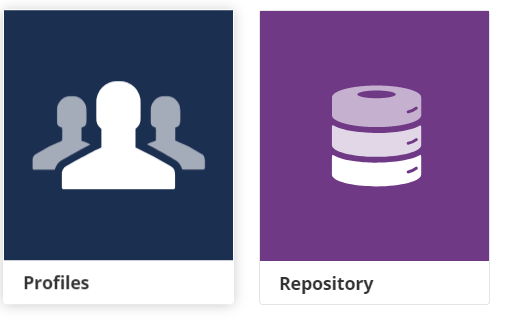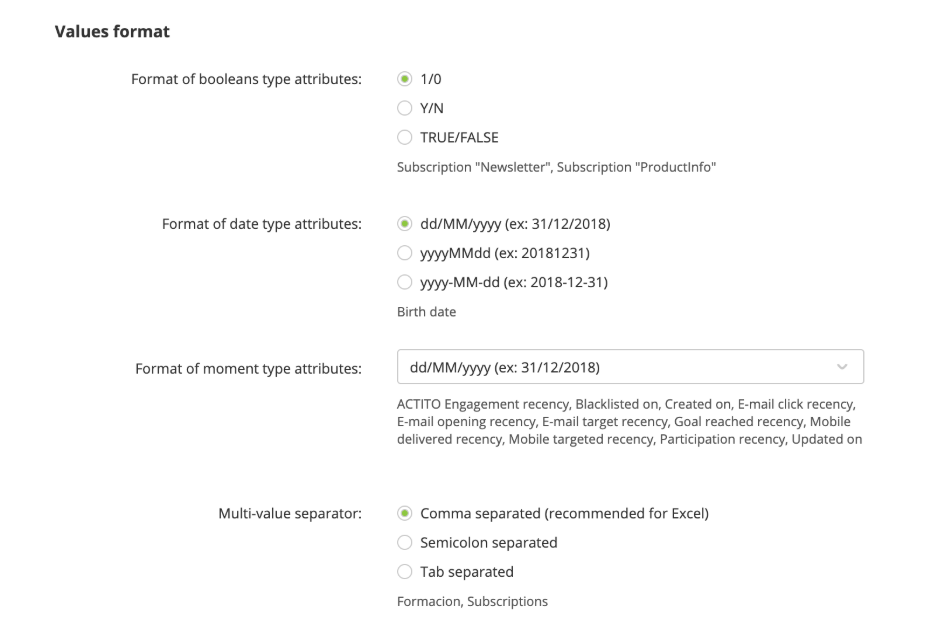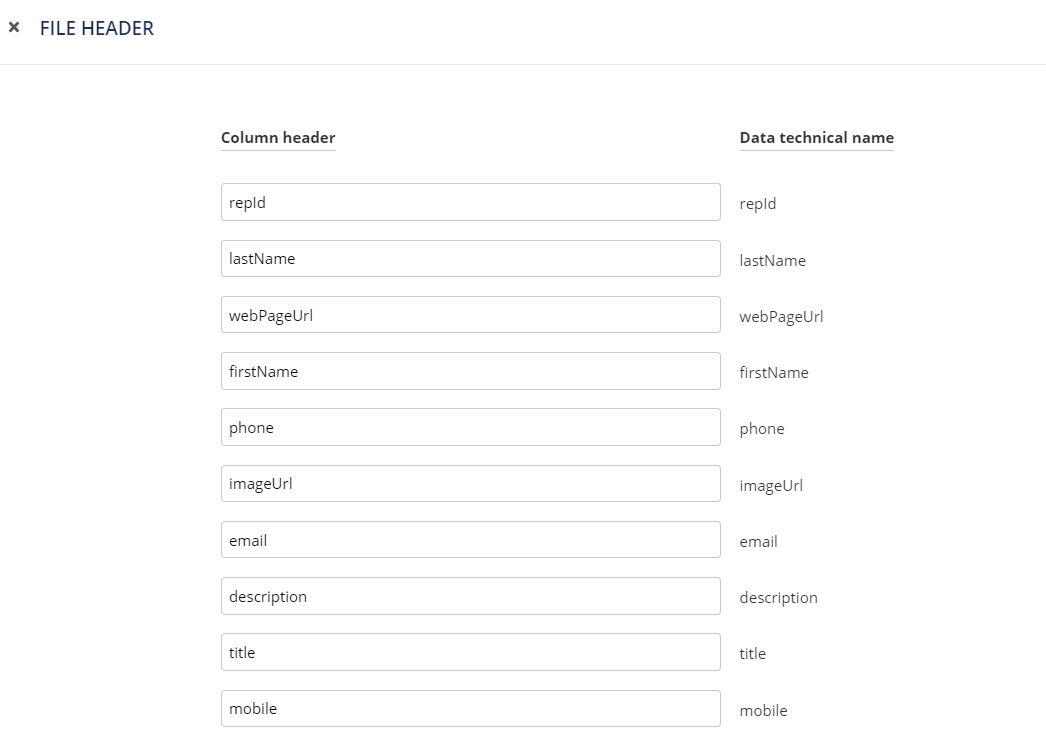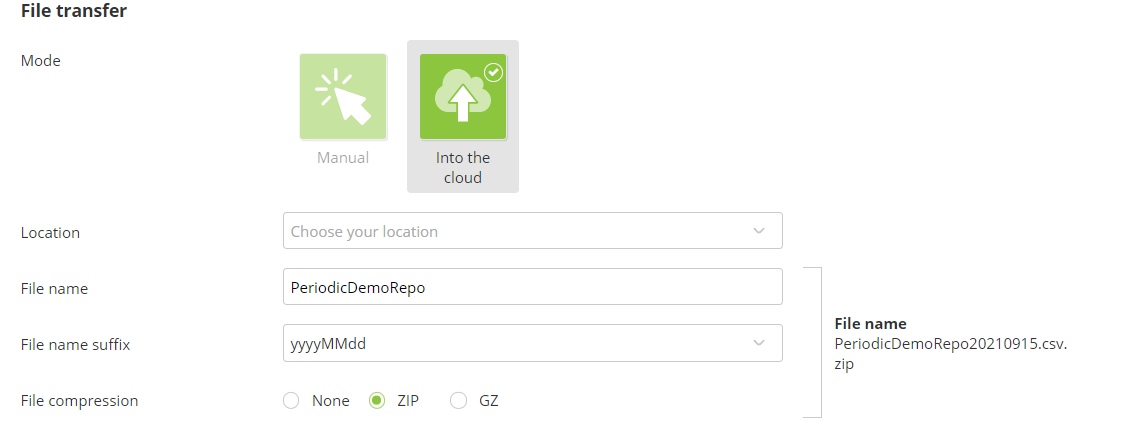Creating Periodic Full Exports
Periodic Full exports are automated exports that occur daily.
They are used to create a daily extract of all the data (or a subset) from a specific table, in opposition to Incremental exports when only new data is taken into account.
Periodic Full are useful to transfer a full profile database or a repository catalog to a third party system, for integrations that require the complete set of data every day.
Due to their potential to involve a heavy load of data, the number of Periodic Full exports is limited to 1 per table every day.
The different types of Periodic Full exports
You can create 2 different types of Periodic Full exports, for the 2 types of tables that can justify a full daily export :
-
Profile exports : Can be used to export data from all the attributes of a profile table, including subscriptions and segmentations. These exports cannot contain data from Custom Tables.
-
Repository exports : Can export data from all the fields of the Repository table, without any data from profiles (The entries in a Repository table are not directly linked to profiles. )

Exporting data
The following guidelines will present you the general process to create a periodic full export.
Each type of export may have some specificities and slightly different steps. They will be highlighted with the same color code as the export.
Step 1: General data
During the first stage of the export creation, you will have to define:
-
The name of your export: this is the prefix that will remain identical in your resulting file.
-
The name suffix: this is a date pattern that will represent the daily increment in your resulting file.
-
The table whose data you want to export.
-
The entity in which this export will be available.

Step 2: Data filter
This step allows to apply filters to select which lines of data you want to export.
In the case of a Profile export, it involves the use of the targeting module, which allow to apply filters based on all the interactions stored in Actito. For detailed information about how to use it, we invite you to read the chapter dedicated to Targeting in Actito.

In a Repository export, there is no "Filter" step. The whole repository catalog will be exported.
Step 3: Choose data
The goal of this step is to define what columns will appear in your export by selecting what attributes to include.
Attributes of the table to export
These are the attributes of the main table that you selected to export. They are colored blue if it is a Profile export, or purple for a Repository export. You can select table components as well as technical data related to interactions (creation moment, update moment,...).
In periodic full exports, you can only export fields from the main table that you selected.

Please note that:
-
It is possible to exclude columns by clicking on unwanted elements, or to click on the 'Unselect all" button and make your choice from scratch.
-
In the interface, you will see the 'display name' given to the attributes. Their 'technical names' will appear by hovering your mouse over the attribute. However, your export will use the 'technical names' of the attributes in the column headers (unless the headers are modified at the next step).
-
To modify the structure of the file obtained after the export, you can change the order of the blocks by dragging and dropping them.
Step 4: Configure export
At this step, you will be able to configure the format of your export.
Format of values
Configure the settings for the values of your file content.
Each of these options will only appear if your export contains attributes of the corresponding type. The relevant attributes are displayed under the format suggestions.
-
Format of "booleans" type attributes : select the format for the attributes whose values are true or false (e.g.: subscriptions displayed as single-columns): 1/0, Y/N, or TRUE/FALSE
-
Format of "date" type attributes: select the format of the attributes of date type (e.g.: birthdate).
-
Format of "moment" type attributes: sele ct the format of attributes of time and date type (e.g.: technical attributes of creation time or of recency). Different levels of accuracy (with or without the time) and format are available.
-
Multi-value separator: sel ect the separator of attributes that can take several values (e.g. single-column subscriptions, hobbies,...). This is not the global separator of the file (selected in the next section).

Format of file
At this step, you will be able to choose the settings of the file.

The File headers are, by default, the technical names of the fields.
They can however be redefined to fit the naming conventions used in your system.

The file is in CSV format, with UTF-8 encoding. You can choose what type of value separator you would like in the file:
commas
semicolons
tabs
Export example
A sample of 10 profiles will allow you to preview the values and columns you will get in your export file.
Step 5: Summary
This stage will let you start the export. Your export summary is divided in different sections.
First, you'll find the 'General Data' section, reminding you of the name, database and entity of your export.

In the targeting section, you will find information on your target, as well as the number of targeted profiles.
In the 'Data' section, you will see all the data fields that will be included in the export.

In the 'Parameters' section, you will be able to verify that you selected the right data and file parameters.

Once you have checked the summary and you are sure that you have correctly defined your export, you can proceed to parameter the way in which you want to transfer the exported data.
As an automated export, Periodic Full exports are automatically dropped into the cloud location of your choice. Therefore, the 'Manual' button will be greyed out when creating one of these exports.
In addition to selecting the remote location among those available in your licence, you must also specify the file name, the name suffix and the type of file compression.

By default, the Transferbox is always available as a cloud location in your licence.
The additional cloud locations options are SFTP or FTPS servers. If you would like to start using this feature, please contact our support or your Actito contact person.
Finally you can schedule your export, which will run every day at the same hour.

Activate the advanced parameters to set up a daily report that will be sent to the selected recipients at every execution of the export.
This report is a notification to inform you if the export was successful, or if it encountered any issue.
